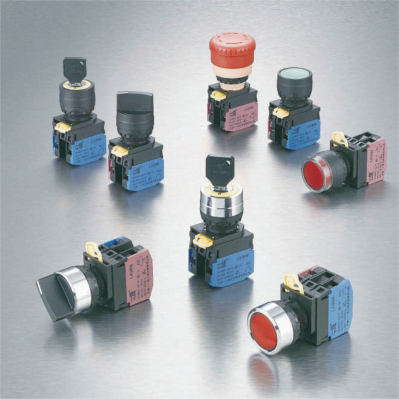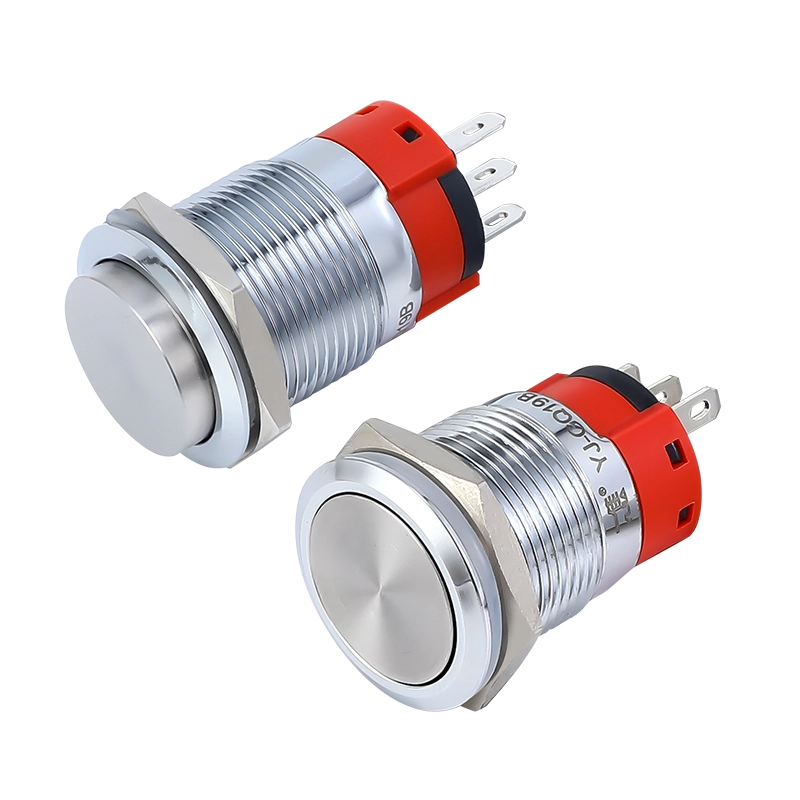Comprehensive analysis of self-locking push button switches
What is a self-locking push button switch?
A self-locking push button switch is a special type of switch that can remain in the on or off state after the user presses the button, and will not return to its original state until the button is pressed again. This switch provides operational convenience as it allows the user to continuously turn a circuit on or off with a single press, eliminating the need to continuously press a button.
Self-locking push button switches are widely used in various electronic equipment and electrical systems, such as household appliances, industrial control systems, and public facilities. The design of this switch makes it ideal for applications that require temporary or intermittent switching of power states, such as starting machines, controlling light switches, etc. Its self-locking feature provides additional safety and operational convenience, allowing users to focus on other operating tasks without worrying about the switch status.
Features
The self-locking push button switch has the following main features:
- Self-locking function: The most significant feature is that the switch automatically locks after being pressed, without the need for continuous manual holding. This means that once activated, the switch will maintain its current state (power on or off) until the user operates it again.
- Ease of use: The design of this switch makes operation simple and intuitive, making it suitable for various environments, especially where fast response is required.
- Reliability: Self-locking push button switches are usually designed to be very sturdy and can withstand frequent use without being easily damaged, ensuring long-term stability and reliability.
- Various designs and configurations: Self-locking switches are available in a variety of sizes, shapes and colors to meet different installation needs and aesthetic requirements.
- Safety: Many self-locking switches are designed with safety locking features to prevent misoperation, especially in critical application environments such as machinery controls and emergency shutdown facilities.
- Adaptability: These switches are capable of adapting to a variety of voltage and current specifications, allowing them to be used in a variety of electrical systems.
Types of self-locking push button switches
The types of self-locking push button switches can be subdivided according to different classification methods, mainly including locking mechanism, reset mechanism and contact configuration classification. The following is a detailed description of each category:
1. Classification by locking mechanism
Self-locking push button switches can be divided into the following types according to their different locking mechanisms:
- Mechanical locking: Locking is achieved through physical mechanisms such as springs or buckles. After the user presses the switch, the mechanical structure automatically locks and maintains the switch state until it is pressed again.
- Electronic locking: Use electronic circuits to control the locking state of the switch. This type of switch can be programmed to implement more complex control logic.
2. Classification by reset mechanism
The reset mechanism refers to the way the switch returns to its original state (usually the off state). The main ones are:
- Manual reset: The user needs to operate the switch again to reset.
- Automatic reset: Automatically resets after a certain period of time or under specific conditions through a built-in mechanism (such as spring force).
3. Classification by contact configuration
Contact configuration refers to the way the electrical contacts are set up inside the switch, which affects how the switch is connected and controlled:
- Single Pole Single Throw (SPST): The switch has a control loop that can only perform a simple on/off task.
- Single Pole Double Throw (SPDT): The switch has a control input and two outputs that can be selectively connected to two different circuits.
- Double pole single throw (DPST): The switch can control two independent circuits, but each circuit has only one switch state.
- Dual Pole Double Throw (DPDT): A switch that can control two independent circuits, each of which can be selectively connected to one of the two outputs.
Application scenarios
Self-locking push button switches are widely used in a variety of occasions and equipment because of their unique functions and convenience. The following are some main application scenarios:
- Household appliances: Self-locking push button switches are commonly found in various household appliances, such as microwave ovens, air conditioners and washing machines, and are used to control the start and stop of the equipment.
- Industrial Control Systems: In industrial automation, this type of switch is used to start and stop machinery, control equipment operation on production lines, and as part of a safety emergency stop button.
- Office equipment: For example, in copiers and scanners, self-locking switches are used to control the power status and other functions of the equipment.
- Transportation: In cars, ships, and airplanes, self-latching pushbutton switches are used to control lights, engine starts, and other critical operations.
- Medical equipment: In medical instruments, such as operating room lighting control and equipment activation, these switches provide reliable and precise control.
- Public facilities and security systems: such as building automatic control systems and emergency exit door control systems, self-locking button switches provide users with a quick response interface.
- Entertainment equipment: In electronic game consoles and audio systems, latching switches are used to control power and other functions.
FAQ
1: What is the lifespan of a self-locking push button switch?
The life of a latching push button switch depends on several factors, including build quality, frequency of use, and environmental conditions. Generally speaking, high-quality switches can withstand tens to hundreds of thousands of operations. Regular maintenance and proper use can extend the life of the switch.
2: Can self-locking push button switches be used in high temperature environments?
Some self-locking push button switches are designed to withstand high temperatures and can work normally in high temperature environments. However, the specific specifications and temperature resistance level of the switch should be confirmed before use to ensure safety and efficiency.
3: What to do if the self-locking button switch fails?
If a switch fails, first check to see if external factors (such as dust accumulation or mechanical damage) caused the failure. If external factors are not the cause, a new switch may be needed. Before replacement, make sure to disconnect the power supply and ask a professional to replace it if necessary.
4: Is the self-locking push button switch waterproof?
There are special waterproof self-locking push button switches on the market, which are suitable for humid or direct contact with water environments. When purchasing, you should check the waterproof rating of the product, such as IP67 or IP68, to ensure that it meets the needs of use.
5: What are the electrical parameters of self-locking push button switches that need to be paid attention to?
When selecting a self-latching push button switch, important electrical parameters include rated voltage and current. Make sure the switch is rated for the electrical requirements of the application environment to avoid overloading and damage.


